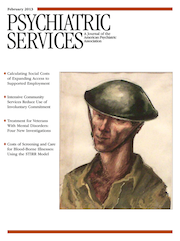Patient and Facility Characteristics Associated With Benzodiazepine Prescribing for Veterans With PTSD
Abstract
Objective
Practice guidelines used in the Veterans Health Administration (VHA) caution against benzodiazepine use by veterans with posttraumatic stress disorder (PTSD) because of inefficacy and safety concerns. Although use has declined, the VHA prescription rate is ≥30% nationally. To inform intervention design, this study examined patient- and facility-level correlates of benzodiazepine prescribing.
Methods
This cross-sectional study used 2009 national administrative VHA data to identify veterans with PTSD, benzodiazepine prescriptions, and various patient and facility characteristics. Correlates of benzodiazepine prescribing were determined with multivariable hierarchical logit models.
Results
Among 137 VHA facilities, 495,309 veterans with PTSD were identified, and 150,571 (30.4%) received a benzodiazepine prescription. Patient characteristics independently associated with benzodiazepine use included female gender, age ≥30 years, rural residence, service-connected disability ≥50%, Vietnam-era service, duration of PTSD diagnosis, and a comorbid anxiety disorder. However, case-mix adjustment for these variables accounted for <1% of prescribing variation. Facility characteristics independently associated with higher use included lower PTSD visit volume, higher rates of duplicate prescribing (concurrent use of more than one drug from a class), and lower rates of trazodone prescribing. These findings were corroborated in replication analyses.
Conclusions
The ultimate goal is to ensure consistent access to guideline-concordant PTSD treatment across the VHA. This study furthered this objective by identifying characteristics associated with benzodiazepine prescribing. Findings suggest that interventions could be designed to target individual high-volume prescribers or influence prescribing culture at the facility level.



